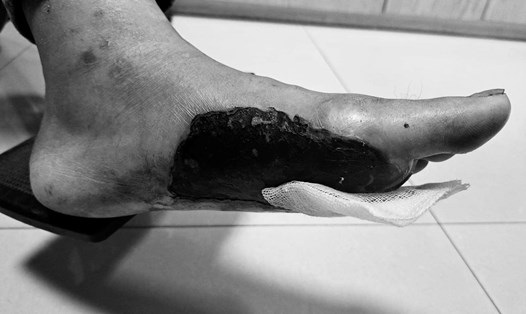The case of patient C.K.E (71 years old, Cambodian) is a warning about the risk of limb necrosis in older adults with underlying diabetes if not diagnosed and treated early for vascular diseases.
Previously, Mr. K.E had surgery to remove three toes (finger 3, 4, 5) at another hospital due to infection. However, the incision did not heal, and the necrosis continued to spread and threatened the remaining fingers. When arriving at City International Hospital (CIH), the location of the three cuts of the toes was still fluid, the location of the fourth toe turned black, painful, the risk of having to amputate the entire foot was very high.
In addition to severe necrosis, the patient also had a spreading infection, burning from the feet up to the calves, constant muscle twitching, causing him to be exhausted and lose sleep for a long time. Notably, Mr. K.E has a history of diabetes, which is a factor that reduces circulation and makes necrotizing tissue spread quickly.
At City International Hospital (CIH), the patient was prescribed an ultrasound, the ultrasound results of the blood vessel doppler showed that the patient was completely blocked in the lower third of the sub-sharpeny artery and blocked the both the front and rear plutes, a condition that prevented blood from supplying soft tissue in the feet. This is a key factor causing necrosis but was overlooked in previous treatment.
Recognizing this as a critical case with the risk of a high limb section, the hospital quickly organized an interdisciplinary consultation including cardiovascular, hormonal, neurological and Orthopedic trauma to develop a comprehensive treatment regimen.
On June 19, 2025, the patient underwent a blood vessel re-examination, a drill to remove the plaque of the temporomandibular artery fibroids, a re-examination of the pre-hanchal artery and a stent to bring blood down to the feet. This is a decisive step to help save the remaining expenditure. Three days later, the doctors continued to remove necrotizing tissue, shaping the tay punch and suturing the wound.
After nearly two weeks of intensive care, the necrotizing condition was controlled, the wound healed well, and the circulation of the limbs improved significantly. The patient was able to walk easily and was discharged from the hospital.
Dr. CKI. Le Van Tuyen - Department of Cardiology, City International Hospital (CIH) said: "This is a typical case showing that early detection and timely treatment of vascular disease can save limbs, avoid acne and improve the quality of life for patients".
The doctor also warned that the elderly, especially diabetics, should not be subjective with any ulcers or small wounds on the limbs. Delaying medical examination or treatment in the wrong direction can lead to serious consequences such as necrosis, amputation, and even death.




